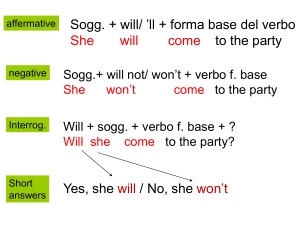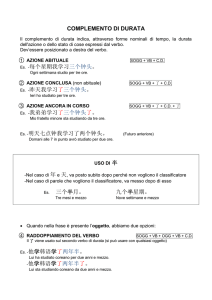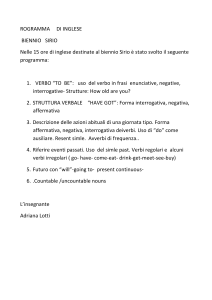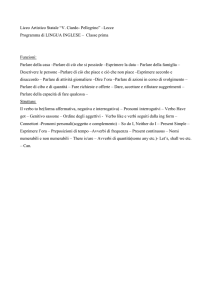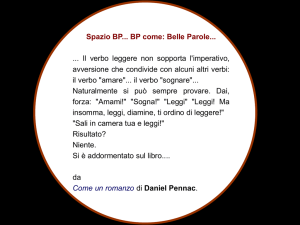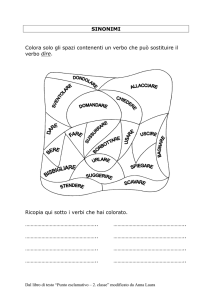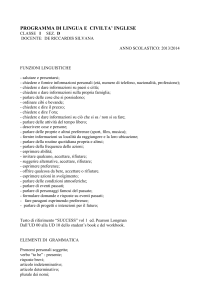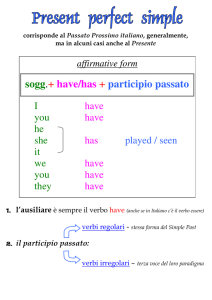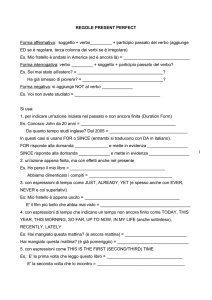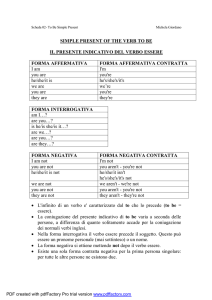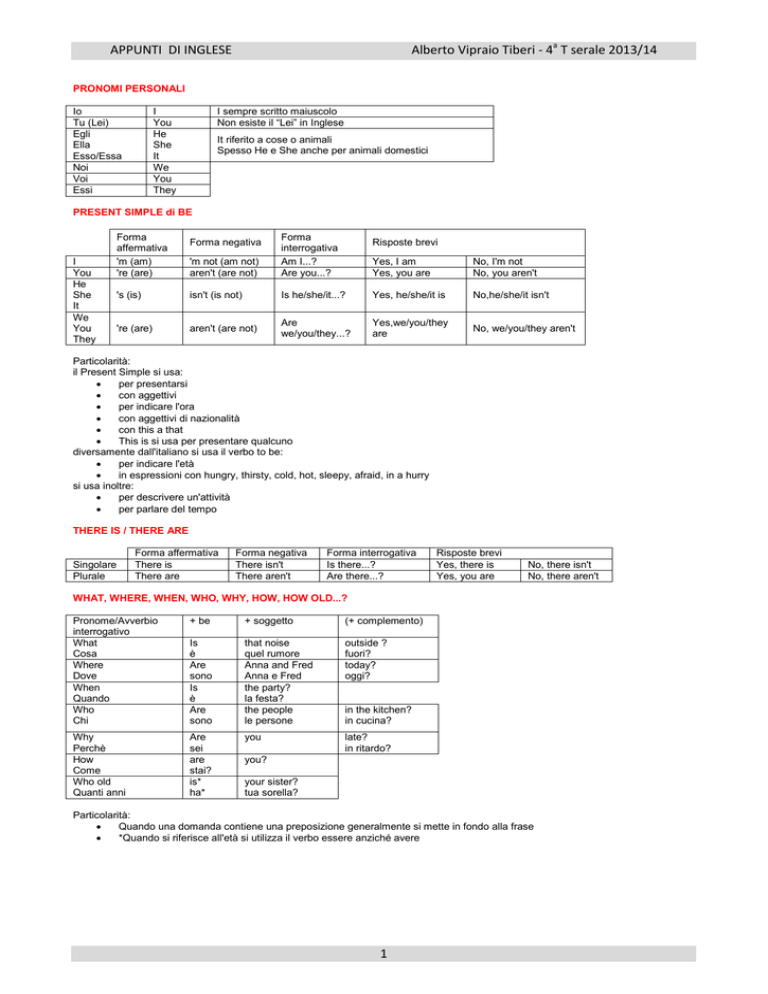
Alberto Vipraio Tiberi - 4a T serale 2013/14
APPUNTI DI INGLESE
PRONOMI PERSONALI
Io
Tu (Lei)
Egli
Ella
Esso/Essa
Noi
Voi
Essi
I
You
He
She
It
We
You
They
I sempre scritto maiuscolo
Non esiste il “Lei” in Inglese
It riferito a cose o animali
Spesso He e She anche per animali domestici
PRESENT SIMPLE di BE
I
You
He
She
It
We
You
They
Forma
affermativa
'm (am)
're (are)
'm not (am not)
aren't (are not)
Forma
interrogativa
Am I...?
Are you...?
's (is)
isn't (is not)
're (are)
aren't (are not)
Forma negativa
Risposte brevi
Yes, I am
Yes, you are
No, I'm not
No, you aren't
Is he/she/it...?
Yes, he/she/it is
No,he/she/it isn't
Are
we/you/they...?
Yes,we/you/they
are
No, we/you/they aren't
Particolarità:
il Present Simple si usa:
per presentarsi
con aggettivi
per indicare l'ora
con aggettivi di nazionalità
con this a that
This is si usa per presentare qualcuno
diversamente dall'italiano si usa il verbo to be:
per indicare l'età
in espressioni con hungry, thirsty, cold, hot, sleepy, afraid, in a hurry
si usa inoltre:
per descrivere un'attività
per parlare del tempo
THERE IS / THERE ARE
Singolare
Plurale
Forma affermativa
There is
There are
Forma negativa
There isn't
There aren't
Forma interrogativa
Is there...?
Are there...?
Risposte brevi
Yes, there is
Yes, you are
No, there isn't
No, there aren't
WHAT, WHERE, WHEN, WHO, WHY, HOW, HOW OLD...?
Pronome/Avverbio
interrogativo
What
Cosa
Where
Dove
When
Quando
Who
Chi
+ be
+ soggetto
(+ complemento)
Is
è
Are
sono
Is
è
Are
sono
that noise
quel rumore
Anna and Fred
Anna e Fred
the party?
la festa?
the people
le persone
outside ?
fuori?
today?
oggi?
Why
Perchè
How
Come
Who old
Quanti anni
Are
sei
are
stai?
is*
ha*
you
late?
in ritardo?
in the kitchen?
in cucina?
you?
your sister?
tua sorella?
Particolarità:
Quando una domanda contiene una preposizione generalmente si mette in fondo alla frase
*Quando si riferisce all'età si utilizza il verbo essere anziché avere
1
Alberto Vipraio Tiberi - 4a T serale 2013/14
APPUNTI DI INGLESE
A / AN – THE
a - an
articolo indeterminativo = un/uno/una/un'
davanti a nomi di persone o cose non meglio specificate
quando ci si riferisce a qualcuno o qualcosa per la prima volta (in seguito si utilizza the)
davanti a nomi di lavori/professioni
per parlare di alcune malattie
davanti a hundred e thousant
a
si usa davanti a parole che iniziano per consonante
eccezioni: si usa anche davanti a parole che iniziano per u quando si pronuncia /ju:/ (university, Europe...)
si usa davanti a parole che iniziano per vocale
eccezioni: si usa anche davanti a parole che iniziano per h muta (hour,honest,honour, heir...)
an
the
articolo determinativo = il/la/le/gli
davanti a persone o cose specifiche
con nomi di cose uniche (the sun, the moon...)
non si usa davanti alla maggioranza dei paesi (... is from Spain)
IN - ON – AT
in
dove, all'interno di quale luogo (My wallet is in my bag)
con nomi di città, paesi e strade (I live in Savona)
on
indica "sopra", a contatto con una superficie
quando un oggetto è situato su una linea (Viareggio is on the coast of Italy)
at
indica una posizione precisa
se prima di un edificio, può indicare fuori, dentro o nei pressi dell'edificio
AGGETTIVI e PRONOMI POSSESSIVI
aggettivo possessivo
my
your
his
her
its
our
their
pronome possessivo
mine
yours
his
hers
its
ours
theirs
AGGETTIVI DIMOSTRATIVI
Singolare
This – questo (vicino)
That – quello (lontano)
Plurale
These – questi (vicini)
Those – quegli (lontani)
Particolarità:
This – that – these – those
Davanti ad un nome assolvono la funzione di aggettivo
Da soli come pronome
Per presentare qualcuno
Per presentarsi al telefono
Non si usa il nome quando il significato è chiaro come pronome
This – these sono spesso usati con l‟avverbio di luogo here
That – those sono spesso usati con l‟avverbio di luogo there
2
Alberto Vipraio Tiberi - 4a T serale 2013/14
APPUNTI DI INGLESE
CAN (per abilità e richieste)
Forma affermativa
I
He/She/It
We
You
They
Forma negativa
I
He/She/It
We
You
They
Forma interrogativa
Can
can
dance
can‟t
dance
I
He/She/It
We
You
They
dance?
Particolarità:
Can si usa:
Per parlare di azioni che siamo o non siamo capaci di fare
Per esprimere impossibilità
Per chiedere e dare il permesso
Per richieste informali o offerte
Con verbi di percezione come see, hear, feel, taste e smell
HAVE GOT
Forma affermativa
I
you
we
they
he
she
it
Forma negativa
I
you
we
they
he
she
it
Forma interrogativa
Have
Has
„ve (have)
got
„s (has)
got
haven‟t (have not)
got
Hasn‟t (has not)
got
I
you
we
they
he
she
it
got…?
got…?
Particolarità:
Can si usa:
E‟ obbligatorio nella forma abbreviata
Non si usa nelle risposte brevi
Per parlare di possesso
Per descrivere l‟aspetto fisico
Per parlare della propria famiglia
Per parlare di malesseri e malattie
3
Alberto Vipraio Tiberi - 4a T serale 2013/14
APPUNTI DI INGLESE
PRONOMI COMPLEMENTO
I pronomi complemento si usano per sostituire il sostantivo:
Robert wants the ice cream
Robert wants it
me
you
him
her
it
she
us
you
them
Mi, me
Ti, te, lei
Gli, lui
Le, lei
Lo, la, lui, lei
she
Vi, voi, loro
Vi, voi. loro
Li, le, loro
Particolarità:
Non precedono mai il verbo principale ma lo seguono
Sue phones her every evening…
Vengono sempre espressi
I hate milk. I don‟t want it.
4
Alberto Vipraio Tiberi - 4a T serale 2013/14
APPUNTI DI INGLESE
NUMERI - DATE
Numeri cardinali
1
2
3
4
5
6
7
8
9
10
11
12
13
14
15
16
17
18
19
20
21
22
30
37
40
50
60
70
80
90
100
0
oh
101
200
One
Two
Three
Four
Five
Six
Seven
Eight
Nine
Ten
Eleven
Twelve
Thirteen
Fourteen
Fifteen
Sixteen
Seventeen
Eighteen
Nineteen
Twenty
Twenty-one
Twenty-two
Thirty
Thirty-seven
Forty
Fifty
Sixty
Seventy
Eighty
Ninety
A hundred (o one hundred)
Numeri ordinali
1°
2°
3°
4°
5°
6°
7°
8°
9°
10°
11°
12°
13°
14°
15°
16°
17°
18°
19°
20°
21°
22°
23°
24°
30°
31°
40°
50°
90°
100°
101°
123°
First
Second
Third
Fourth
Fifth
Sixth
Seventh
Eighth
Ninth
Tenth
Eleventh
Twelfth
Thirteenth
Fourteenth
Fifteenth
Sixteenth
Seventeenth
Eighteenth
Nineteenth
Twentieth
Twenty-first
Twenty-second
Twenty-third
Twentyfourth
Thirtieth
Thirty-first
Fortieth
Fiftieth
Ninetieth
Hundredth
Hundred and first
Hundred and twenty-third
nought
Numeri telefonici, date
A hundred and one
Two hundred
999
Nine hundred and ninety-nine
1.000
A thousand o one thousand
1.001
A thousand and one
2.225
Two thousand, two hundred and twenty-five
100.000
A hundred thousand
1.000.000
A million
5.000.000
Five million
1.000.000.000
A billion
1.000.000.000.000 A trillion
Hundred, thousand, million e billion hanno il plurale solo nelle
espressioni come centinaia, migliaia, milioni e miliardi
Frazioni e decimali
½
1/3
¼
2/3
3/4
5/8
1½
2¼
5 3/4
1.5
2.25
5.75
A half
A third
A quarter
Two thirds
Three quarters
Five eighths
one and a half
Two and a quarter
Five and three quarters
One point five
Two point two five
Five point seven five
5
Alberto Vipraio Tiberi - 4a T serale 2013/14
APPUNTI DI INGLESE
CHIEDERE E DIRE L’ORA
What time is it? What‟s the time?
Can/Could you tell me the time?
Che ora è? Mi sa dire l‟ora?
It‟s three o‟ cloock
Due e cinque
Due e un quarto
Due e venti
Due e mezza
Tre meno un quarto
Tre meno cinque
Five past two – two oh five
Quarter past two – two fifteen
Twenty past two – two twenty
Half past two – two thirty
Quarter to three – two forty-five
Five to three – two fifty-five
La numerazione 13-24 si usa solo negli orari ufficiali (treni, aerie, ecc.).
La numerazione 1-12 si usano seguiti da am (ante meridian) e pm (post meridian).
In the morning – di mattina
In the aftermoon – di pomeriggio
In the evening – di sera
At night – di notte
At midday (noon) – a mezzogiorno
At midnight – a mezzanotte
PREPOSIZIONI DI TEMPO – AT, IN, ON
at
in
on
Ore – at 4 am, at midnight
Weekend – at the weekend
Festività – at Christmas
Pasti – at lunch, at dinner
Anni – in 2003
Mesi – in August
Stagioni – in summer
Parti del giorno – in the morning
Giorni settimana – see you on monday
Giorno + momento della giornata – the exam is on Thursday morning
Date o giorni specifi – on 14th april April
Parti del giorno – in the morning, in the evening (in the mornin), eccezioni: at
night – di notte
Giorno della settimana – see you on Monday
Giorno + momento della giornata – the exam is on Thursday morning
Date/giorni specifici – on 14th April
Al posto di in, on e at possiamo trovare: this, next, last e every.
Si usa from… to/until per descrivere un periodo di tempo. From… to – dalle… alle
Until… – fino alle…
IMPERATIVO
Stand up
Alzati
Infinito senza to
Si usa sia alla seconda persona singolare (tu) che al plurale (voi)
Forma negativa: si forma con don‟t
Don‟t stop!
Per la prima persona plurale (noi) si usa let‟s + infinito senza to
Let‟s go back!
Torniamo indietro
La forma negativa si forma con let‟s not o don‟t let‟s (più informale)
Let‟s not go back. Don‟t let‟s go back.
Particolarità:
Si usa
Per dare ordini Stop talking! – Smetti di parlare!
Per dare istruzioni Press enter to start a new paragraph – Premi/premete il tasto invio per andare a capo
Per dare indicazioni stradali Turn right at the bank – Gira/girate a destra (quando arrivi/arrivate) alla banca
Nel linguaggio informale per dare consigli e fare richieste Don‟t buy that one – Non comprarlo
Per augurare qualcosa Have a good trip! – Buon viaggio!
Per offrire qualcosa Take a seat – Siediti
Per essere più formali o cortesi si aggiunge „please‟ Pass me the salt, please – Passami il sale, per favore.
6
Alberto Vipraio Tiberi - 4a T serale 2013/14
APPUNTI DI INGLESE
PRESENT SIMPLE
si usa per descrivere:
- fatti generali che risultano sempre veri (Maria comes from Bologna - Maria viene da Bologna);
- verità generali e leggi della natura The sun rises in the east - Il sole sorge ad est);
- azioni ripetute ed abituali (Harry arriva spesso in ritardo);
- con espressioni che indicano frequenza (twice a day, usually, often, sometimes).
Forma
Sogg + Verbo senza “to”
I, you,we,they live
Affermativa *
He, she, it lives
Forma
Sogg + “do not” (don‟t) + verbo senza to
I (…) do not live
Negativa *
Sogg + “does not” (doesn‟t) + verbo senza “to”
He (…) does not live
Forma
Do + sogg + verbo senza “to”
Do I (…) they live?
Interrogativa *
Does + sogg + verbo senza “to”
Does he (…) live?
Forma
Do not + sogg + verbo senza “to”
Don‟t I live?
Interrogativa
Does not + sogg + verbo senza “to”
Does not he (…) live?
Negativa *
a
* no “s” alla 3 persona singolare
+ particolarità pag. 56
Yes, I do ? No, I don‟t
He do not ? He don‟t
AVVERBI DI FREQUENZA
Usually
di solito
Normally normalmente
Often
spesso
Sometimes
qualche volta
Occasionally
ogni tanto
Rarely
raramente
Seldom
di rado
Hardly ever
quasi mai
Gli avverbi di frequenza, solitamente si collocano prima del verbo principale ma vanno dopo il verbo to be e gli ausiliari.
I always go to bed at eleven.
She is always late for school.
You must never be late again.
Gli avverbi di frequenza si usano solitamente con il Present Simple e indicano con che frequenza, quante volte (al giorno, al mese per
es.) si compiono certe azioni.
Si usano Every (ogni) once a/twice a/three times a day per precisare con quale frequenza avvengono certe azioni.
Le frasi che contengono avverbi di frequenza rispondono alla domanda how often? (quante volte/quanto spesso?)
Ever e never (mai)
Nelle domande si usa ever e nelle affermative si usa never.
Do you ever read books in English? I never read books in English.
Never (non.. mai) e hardly ever (quasi mai) hanno un significato negative, perciò richiedono la forma affermativa del verbo.
Janet never drink wine.
I hardly ever watch the news.
HAVE e HAVE GOT
Il verbo have ha due costruzioni, una con got, l‟altra con l‟ausiliare do/does.
Costruzione con
got
Costruzione con
do/does
Forma affermativa
Forma interrogativa
Forma negativa
I/you/we/they have
got
He/she/it has got
I/you/we/they have
He/she/it has
Have I/you/we/they
got?
Has he/she/it got?
Do I/you/we/they
have?
Does he/she/it
have?
I/you/we/they
haven‟t got?
He/she/it hasn‟t got
I/you/we/they don‟t
have?
He/she/it doesn‟t
have
L‟uso di got dopo have/has è:
Facoltativo nelle affermative We have got a new teacher - We have a new teacher
Obbligatorio nelle interrogative e nelle negative Have you got a bike?
Errato nelle risposte brevi Have you you got a piece of paper? Yes, I have got.
Errato nelle seguenti espressioni
Have breakfast/lunch/supper…
Have a shower/a bath/a wash…
Have a trip/journey
Have fun/a good time
Have a party/an argument
7
Risposte brevi
affermative
Yes, I/you/we/they
have
Yes, he/she/it has
Yes, I/you/we/they
do
Yes, he/she/it does
Risposte brevi
negative
No, I/you/we/they
haven‟t
No, he/she/it hasn‟t
No I/you/we/they
don‟t
No, he/she/it
doesn‟t
Alberto Vipraio Tiberi - 4a T serale 2013/14
APPUNTI DI INGLESE
INFINITO e INFINITO DI SCOPO
INFINITO
L‟infinito presente si ottiene con to + la forma base del verbo.
La forma negativa si ottiene aggiungendo not prima di to: to be or
not to be
Si usa:
Come soggetto di una frase
To work as a photographer is my dream
Dopo aggettivi che esprimono stati d‟animo come
happy, pleased, lovely, proud
In frasi con it + to be + aggettivo/sostantivo
It is impossible to find a parking space
Come oggetto dopo alcuni verbi come want, wish,
choose,decide, hope, afford, plan, pretend, deserve,
remember, forget
INFINITO DI SCOPO
L‟infinito con to si usa anche per esprimere scopo.
I opened the window to let in some fresh air.
Nella forma negative è necessario aggiungere so as o in order.
Osserva anche la posizione di not nelle negative.
She pretended to be ill so as not to go to school.
To non si usa:
Dopo verbi modali must, can, could, may, might, will, shall e
should You must hand in the test by 12,00
Dopo would, had better e would rather
Con let e make
Dopo I verbi di percezione feel, hear, see e watch
LA FORMA IN -ING
Corrisponde in italiano al gerundio, all‟infinito sostantivo e al participio presente.
Si costruisce con l‟infinito del verbo + ing.
Walk – walking
Eat – eating
Speak – speaking
Il gerundio può essere usato in funzione sostantivale
He likes swimming – gli piace nuotare (=il nuoto)
La forma in –ing si usa:
dopo verbi come like, love, hate, enjoy, stop, finish, mind, imagine, admit, deny, suggest.
She love swimming – ama nuotare
spesso dopo go per parlare di sport o hobby che implicano spostamento
go swimming, go skiing, go jogging
dopo le preposizioni about, at, in, for, before
how about going shopping later?
Come soggetto di una frase
Running is a good exercise
In alcune espressioni come it‟s (not) worth [(non) ne vale la pena], it‟s no good, it‟s no use (non serve a niente), there‟s no
point (non ha senso)
Con la funzione di gerundio nei tempi continui
The number is growing
La forma in –ing può anche avere la funzione di participio presente
A growing problem - un problema crescente
PRESENT CONTINUOUS
si usa:
- per parlare di azioni che avvengono al momento in cui si parla (My brother's talking on the phone now);
- per parlare di eventi o azioni che avvengono al presente, ma non necessariamente nel momento in cui si parla (I'm reading a very
good book at the moment);
-per descrivere foto o illustriazioni (That's my grandmother. She's standing next to my uncle. He's eating something);
- con always indica irritazione per un'azione ripetuta (They're always complaining!);
- per parlare del futuro quando è programmato (I'm having lunch with John tomorrow);
- spesso con parole o frasi che indicano un periodo di tempo non concluso come: at the moment, now, today, this week, this years
(I'm going home now).
Forma
Sogg + “to be” al Present Simple + verbo in “ing”
I am speaking
Affermativa
Forma
Sogg + “not to be” al Present Simple + verbo in
I‟m not speaking
Negativa
“ing”
Forma
“To be” + sogg + verbo al Present Simple in “ing”
Am I speaking?
Yes, I am –
Interrogativa
No, I am not – No, you aren‟t
Forma
“Not to be” + sogg + verbo in “ing”
Am I not speaking?
Interrogativa
Negativa
Coniugazione di “to be” a pag. 10
+ particolarità pag. 70
8
Alberto Vipraio Tiberi - 4a T serale 2013/14
APPUNTI DI INGLESE
LIKE e WOULD LIKE
Like come preposizione
In generale like significa “come”
She‟s like her mother – è come sua madre
Like è usato anche nella struttura What + be + sogg + like? Per chiedere una descrizione
What‟s German like? It‟s quite difficult – Com‟è il Tedesco? E‟ piuttosto difficile.
La struttura What + look + like? Si usa per chiedere descrizioni fisiche
What does your sister look like? She‟s blonde – Com‟è (fisicamente) tua sorella? E‟ bionda.
La stessa struttura What… like? si usa con verbi di percezione come taste, sound, feel, smell
What does this coffe taste like? It taste like dishwater – Di cosa sa questo caffè? Sa di acqua (dei piatti)
Like come verbo
A differenza del nostro “piacere” in italiano like ha una costruzione personale
I like football – Mi piace il calcio
Like e would like differiscono sia nel significato che nella costruzione
I like tea – Mi piace il tè
I would like some tea (richiesta specifica) – Vorrei del tè
Would… like si usa anche per offrire qualcosa
Would you like a cup of hot chocolate?
MAKE e DO
Sia to make che to do tracducono l‟italiano fare ma sono usati in differenti contesti:
do indica fare in senso generale
make indica creare, produrre
inoltre:
What are you doing? - Cosa stai facendo?
I‟m making dinner - Sto facendo la cena
What are you making? – Cosa stai prepartando?
PAST SIMPLE di BE e HAVE
Forma
Sogg + was/were - had
Affermativa
Forma
Sogg + wasn't/weren't - hadn't
Negativa
Forma
Was/Were - Had + sogg... ?
Interrogativa
Forma
Wasn't/Weren't - Hadn't + sogg... ?
Interrogativa
Negativa
It was could in London
It wasn't could in London
Was it could in London?
Yes, It was
No, It wasn't
Wasn't it could in London?
PAST SIMPLE
si usa:
- per azioni, situazioni o stati conclusi nel passato (We were in Turin last week);
- si usa was/were anche per costruire il Past Simple di there is/there are (There was a great party last night/Were there many
people?);
- quando parliamo di un tempo specifico del passato (I was at Hampton Court on Sunday) mentre in italiano si può usare sia il
passato prossimo, sia l'imperfetto, sia il passato remoto;
- per parlare della nascita (I was born in Paris in 1975).
Forma
Sogg + verbo all‟infinito senza “to” *
I lived in London
Affermativa
I forgot my book
Forma
Sogg + did not (didn‟) + verbo all‟infinito senza “to”
I didn‟t live in London
Negativa
I didn‟t forget my book
Forma
“Did” + sogg + verbo all‟infinito senza “to”
Did I live in London?
Yes, I did
Interrogativa
Did I forget my book?
No, I did not – No, I didn‟t
Forma
“Did not” (didn‟t) + sogg + verbo all‟infinito senza
Didn‟t I live in London?
Interrogativa
“to” *
Didn‟t I forget my book?
Negativa
a
*verbo irregolare (2 voce paradigma)
+ particolarità pag. 99
Paradigmi pag. 496
9
Alberto Vipraio Tiberi - 4a T serale 2013/14
APPUNTI DI INGLESE
PAST SIMPLE dei verbi irregolari
I verbi irregolari non formano il Past Simple con –ed.
Ciascun verbo ha una forma diversa:
do…. did
eat…. ate
go…. went
alcuni verbi cambiano vocale al passato:
come… came
drive…. drove
get… got
altri rimangono invariati:
cost… cost
hit… hit
let…. let
anche per i verbi irregolari, come per quelli regolari, nella forma negativa si usa did not, didn‟t + la forma base del verbo
I didn‟t go to school last week
Anche per I verbi irregolari si antepone did al soggetto
Did you go to school last week? Yes, I did.
Le risposte brevi per I verbi irregolari seguono le regole di quelli regolari
VERBI IRREGOLARI
Infinito
Past Simple
Past Participle
Traduzione
awake
be
bear
beat
become
begin
bend
beset
bet
bid
bind
bite
bleed
blow
break
breed
bring
broadcast
build
burn
burst
buy
cast
catch
choose
cling
come
cost
creep
cut
deal
dig
dive
do
draw
dream
drive
drink
eat
fall
feed
feel
fight
find
fit
flee
fling
fly
forbid
forget
forego (forgo)
forgive
forsake
freeze
get
awoke
was, were
bore
beat
became
began
bent
beset
bet
bid/bade
bound
bit
bled
blew
broke
bred
brought
broadcast
built
burned/burnt
burst
bought
cast
caught
chose
clung
came
cost
crept
cut
dealt
dug
dived/dove
did
drew
dreamed/dreamt
drove
drank
ate
fell
fed
felt
fought
found
fit
fled
flung
flew
forbade
forgot
forewent
forgave
forsook
froze
got
awoken
been
born
beat
become
begun
bent
beset
bet
bid/bidden
bound
bitten
bled
blown
broken
bred
brought
broadcast
built
burned/burnt
burst
bought
cast
caught
chosen
clung
come
cost
crept
cut
dealt
dug
dived
done
drawn
dreamed/dreamt
driven
drunk
eaten
fallen
fed
felt
fought
found
fit
fled
flung
flown
forbidden
forgotten
foregone
forgiven
forsaken
frozen
gotten
svegliarsi
essere
sostenere/sopportare
battere/vincere
diventare
cominciare
piegare/curvare
assediare
scommettere
offrire (in un asta)
fissare/trattenere
mordere
svuotare/sanguinare
soffiare
rompere
produrre
portare
trasmettere
costruire
bruciare
crollare/scoppiare
comprare
gettare/distendere
prendere
scegliere
abbracciare
venire
costare
strisciare
tagliare
dare/distribuire
scavare
tuffare
fare
disegnare
sognare
guidare
bere
mangiare
cadere
nutrire
sentire
combattere
trovare
calzare
fuggire
lanciare/gettare
volare
proibire
dimenticare
rinunciare
perdonare
rinunciare
congelare
prendere
10
Alberto Vipraio Tiberi - 4a T serale 2013/14
APPUNTI DI INGLESE
Infinito
Past Simple
Past Participle
Traduzione
give
go
grind
grow
hang
hear
hide
hit
hold
hurt
keep
kneel
knit
know
lay
lead
leap
learn
leave
lend
let
lie
light
lose
make
mean
meet
misspell
mistake
mow
overcome
overdo
overtake
overthrow
pay
plead
prove
put
quit
read
rid
ride
ring
rise
run
saw
say
see
seek
sell
send
set
sew
shake
shave
shear
shed
shine
shoe
shoot
show
shrink
shut
sing
sink
sit
sleep
slay
slide
sling
slit
smite
sow
speak
speed
spend
spill
spin
spit
split
spread
spring
stand
steal
stick
sting
gave
went
ground
grew
hung
heard
hid
hit
held
hurt
kept
knelt
knit
knew
laid
led
leaped/lept
learned/learnt
left
lent
let
lay
lighted/lit
lost
made
meant
met
misspelled/misspelt
mistook
mowed
overcame
overdid
overtook
overthrew
paid
pled
proved
put
quit
read
rid
rode
rang
rose
ran
sawed
said
saw
sought
sold
sent
set
sewed
shook
shaved
shore
shed
shone
shoed
shot
showed
shrank
shut
sang
sank
sat
slept
slew
slid
slung
slit
smote
sowed
spoke
sped
spent
spilled/spilt
spun
spit/spat
split
spread
sprang/sprung
stood
stole
stuck
stung
given
gone
ground
grown
hung
heard
hidden
hit
held
hurt
kept
knelt
knit
know
laid
led
leaped/lept
learned/learnt
left
lent
let
lain
lighted
lost
made
meant
met
misspelled/misspelt
mistaken
mowed/mown
overcome
overdone
overtaken
overthrown sovvertire
paid
pled
proved/proven
put
quit
read
rid
ridden
rung
risen
run
sawed/sawn
said
seen
sought
sold
sent
set
sewed/sewn
shaken
shaved/shaven
shorn
shed
shone
shoed/shod
shot
showed/shown
shrunk
shut
sung
sunk
sat
slept
slain
slid
slung
slit
smitten
sowed/sown
spoken
sped
spent
spilled/spilt far
spun
spit
split
spread
sprung
stood
stolen
stuck
stung
dare
andare
triturare
crescere
appendere
sentire
nascondere
colpire
tenere
ferire
conservare
inginocchiare
fare a maglia
conoscere
distendere
condurre
saltare
imparare
lasciare
prestare
lasciare
mentire/stare
illuminare
perdere
costruire
intendere
incontrare
scrivere scorrettamente
confondere
falciare
vincere/dominare
strafare
orpassare
pagare
implorare
dimostrare
mettere
lasciare
leggere
liberarsi da
cavalcare
suonare
salire/aumentare
correre
segare
dire
vedere
cercare
vendere
spedire
mettere/collocare
cucire
agitare
radere
tranciare
spargere/versare
fare luce
ferrare
sparare
mostrare
ridurre
chiudere
cantare
affondare
sedere
dormire
uccidere
scorrere
lanciare/scagliare
tagliare
percuotere
divertire
parlare
correre
spendere
fuoriscire
ruotare
sputare
spaccare/rompere
aprire/spiegare
saltare/balzare
alzarsi/stare
rubare
attaccare
pungere
11
Alberto Vipraio Tiberi - 4a T serale 2013/14
APPUNTI DI INGLESE
Infinito
Past Simple
Past Participle
Traduzione
stink
stride
strike
string
strive
swear
sweep
swell
swim
swing
take
teach
tear
tell
think
thrive
throw
thrust
tread
understand
uphold
upset
wake
wear
weave
wed
weep
wind
win
withhold
withstand
wring
write
stank
strod
struck
strung
strove
swore
swept
swelled
swam
swung
took
taught
tore
told
thought
thrived/throve
threw
thrust
trod
understood
upheld
upset
woke
wore
weaved/wove
wed
wept
wound
won
withheld
withstood
wrung
wrote
stunk
stridden
struck
strung
striven
sworn
swept
swelled/swollen
swum
swung
taken
taught
torn
told
thought
thrived
thrown
thrust
trodden
understood
upheld
upset
woken
worn
weaved/woven
wed
wept
wound
won
withheld
withstood
wrung
written
puzzare
camminare
colpire
infilare
lottare
bestemmiare
travolgere
gonfiare
nuotare
agitare
prendere
insegnare
strappare/staccare
raccontare
pensare
prosperare
lanciare/gettare
spingere
camminare
capire
confermare
disturbare
alzarsi/svegliarsi
vestire
intrecciare
sposare
piangere
avvolgere
vincere
trattenere
sfidare
strizzare
scrivere
PAST CONTINUOUS
si usa:
- per esprimere un'azione che era in corso di svolgimento in un momento definito del passato (at 9.30 this morning I was driving to
work);
-per descrivere due azioni che si svolgevano contemporaneamente in un momento definito ( At 7.00 o'clock last night I was having a
bath while my mother was preparing dinner).
Forma
Sogg + “to be” al Present Simple + verbo in “ing”
I was speaking
Affermativa
Forma
Sogg + “not to be” al Present Simple + verbo in
I was not speaking
Negativa
“ing”
Forma
“To be” + sogg + verbo al Present Simple in “ing”
Was I speaking?
Yes, I was – Yes, you were
Interrogativa
No, I was not – No, you
weren‟t
Forma
“Not to be” + sogg + verbo in “ing”
Was I not speaking?
Interrogativa
Negativa
Coniugazione di “to be” a pag. 56
+ particolarità pag. 70
PAST SIMPLE vs PAST CONTINUOUS
Si usa il Past Simple per descrivere un‟azione conclusasi in un
Si usa il Past Continuos per descrivere un‟azione (o azioni) in
momento specifico nel passato con espressioni di tempo come
fase di svolgimento in un momento specifico del passato
yesterday, last night, at two o‟clock
At 8 o‟clock Robbie was doing his homework
Robbie finished his homework at 10 o‟clock
Alle 8 Robbie faceva (stave facendo) I compiti
Si usa il Past Simple per parlare di un‟azione specifica conclusasi
Si usa il Past Continuos per parlare di un‟azione che era in corso
nel passato
quando ne è accaduta un‟altra
We lived in Australia for two years
While we were living in Australia, we met the Johnsons
Abbiamo vissuto in Australia per due anni
Mentre vivevamo in Australia abbiamo conosciuto I Johnson
Ùsi usa il Past Simple per descrivere una serie di eventi successi
uno dopo l‟altro nel passato
I got up, made my bed and had a shower
Mi sono alzata, ho fatto il letto e mi sono fatta la doccia
12
Alberto Vipraio Tiberi - 4a T serale 2013/14
APPUNTI DI INGLESE
PRESENT PERFECT
si usa quando un'azione o situazione del passato ha un collegamento con il presente:
- per descrivere un'azione avvenuta nel passato senza specificare quando è avvenuta (John come home - ora è qui);
- un'azione avvenuta nel passato ma che ha ancora riflessi nel presente (I've lost my kies. I can't get into the house);
- un'azione avvenuta in un tempo non concluso e per parlare di esperienze fatte in passato e presumibilmente ripetibili;
- si usa con ever e never (mai) per parlare di esperienze in un passato non concluso senza una precisa collocazione temporale
(She's never travelled by plane/Have they ever worked together? Ever nelle frasi affermative o interrogative, Never in quelle
negative);
- con just/appena collocato prima del participio passato;
- con already/già collocato prima del participio passato;
- yet/ancora (nelle frasi negative),/già (nelle frasi interrogative) posto sempre in fondo alla frase;
- rispondendo alle frasi interrogative con How long? Since (... dal 2010), For (... per sei anni).
Forma
Sogg + have/has + verbo al participio passato
I've played
Affermativa
Forma
Sogg + haven't/hasn't + verbo al participio
I haven't played
Negativa
passato
Forma
Have/Has+ sogg + verbo al participio passato
Have I speaking?
Yes, I have
Interrogativa
No, I haven't
Forma
Haven't/Hasn't + sogg + verbo al participio
Haven't I speaking?
Interrogativa
passato
Negativa
PRESENT PERFECT con ever e never
Si us ail Present Perfect con ever e never (=mai) per parlare di esperienze in un passato non concluso senza una precisa collocazione
temporale. Ever e never si collocano prima del particio passato.
She‟s never travelled by plane
Non ho mai viaggiato in aereo
Have they ever worked together?
Hanno mai lavorato insieme?
Ever si usa nelle frasi affermative e interrogative e never in quelle negative
That‟s the best film I‟ve ever seen
È il miglior film che abbia mai visto.
Si usa ever per descrivere un‟esperienza fatta per la prima volta
It‟s the first time I‟ve ever travelled by plane
È la prima volta che ho viaggiato in aereo
I‟ve hardly ever been late
Non sono quasi mai stata in ritardo
PRESENT PERFECT con just, already, jet e so far
Il Present Perfect si usa spesso con le seguenti espressioni temporali:
just (appena) si colloca prima del Participio Passato
Is Peter there? No, he‟s just gone out
C‟è Peter? No, è appena uscito
already (già) si colloca prima del Particio Passato nelle forme affermative
I‟ve already eaten. I had lunch at 12:00
Ho già mangiato. Ho pranzato alle 12:00
Si può anche usare already nelle frasi interrogative quando si vuole esprimere sorpresa per le conclusioni di un‟azione
Have you finished your homework already? You‟ve been really quick!
Hai già finite I compiti? Sei stato molto veloce!
yet (ancora/già) nelle frasi negative significa “ancora” mentre in quelle interrogative significa “già”, è sempre posto in fondo alla frase e
non si può usare nella forma affermativa
I haven‟t finished yet
Non ho ancora finito
still (ancora) si usa come yet nelle frasi negative ma, a differenza di yet, esprime una certa sorpresa o impazienza per la situazione
descritta, si mette prima dell‟ausiliare have/has
Tom still hasn‟t tidied his room. (I‟ve asked him a hundred times!) Tom hasn‟t tidied his room yet.
Tom non ha ancora messo in ordine la sua camera
so far (finora) può stare all‟inizio della frase o dopo il verbo principale
So far the best test I‟ve checked is Luisa‟s. The best test I‟ve checked so far is Luisa‟s
Il test di Luisa è il migliore che abbia corretto finora
PRESENT PERFECT con since e for
Si usa il Present Perfect spesso per rispondere a domande con How long
How long have you lived in this town?
Da quanto tempo vivi in questa città?
Si usa since quando ci si riferisce da un momento specifico nel tempo
I‟ve lived in this town since 2003
Vivo in questa città dal 2003
Si usa for quando ci si riferisce ad un periodo di tempo definito
I‟ve lived in this town tor six years, I still live here
13
Alberto Vipraio Tiberi - 4a T serale 2013/14
APPUNTI DI INGLESE
BEEN e GONE
Il participio passato di go si traduce sia con been (=stato/andato) che gone (=andato)
Where‟s David? He has gone to the supermarket.
Dove è David? È andato al supermercato (e non è ancora tornato)
Paul „s been to Spain. He came back yesterday
Paul è stato in Spagna. È ritornato ieri.
Si usa been quando la persona è andata e poi tornata
David has been to the shop. The fridge is full
David è andato al negozio. Il frigo è pieno
Si usa gone invece quando la persona è andata via definitivamente o non è ancora tornata
Paul‟s gone to Spain. He‟s got a job there
Paul è andato in Spagna. Ha trovato un lavoro lì
PRESENT PERFECT vs PAST SIMPLE
si usa quando un'azione o situazione del passato ha un
si usa:
collegamento con il presente:
- per azioni, situazioni o stati conclusi nel passato (We were in
- per descrivere un'azione avvenuta nel passato senza
Turin last week);
specificare quando è avvenuta (John come home - ora è qui);
- si usa was/were anche per costruire il Past Simple di there
- un'azione avvenuta nel passato ma che ha ancora riflessi nel
is/there are (There was a great party last night/Were there many
presente (I've lost my kies. I can't get into the house);
people?);
- un'azione avvenuta in un tempo non concluso e per parlare di
- quando parliamo di un tempo specifico del passato (I was at
esperienze fatte in passato e presumibilmente ripetibili;
Hampton Court on Sunday) mentre in italiano si può usare sia il
- si usa con ever e never (mai) per parlare di esperienze in un
passato prossimo, sia l'imperfetto, sia il passato remoto;
passato non concluso senza una precisa collocazione temporale
- per parlare della nascita (I was born in Paris in 1975).
(She's never travelled by plane/Have they ever worked together?
Ever nelle frasi affermative o interrogative, Never in quelle
negative);
- con just/appena collocato prima del participio passato;
- con already/già collocato prima del participio passato;
- yet/ancora (nelle frasi negative),/già (nelle frasi interrogative)
posto sempre in fondo alla frase;
- rispondendo alle frasi interrogative con How long? Since (... dal
2010), For (... per sei anni).
Forma
Sogg + have/has
I've played
Forma
Sogg + verbo
I lived in
Affermativa
+ verbo al
Affermativa
all‟infinito
London
participio
senza “to” *
I forgot my
passato
book
Forma
Sogg +
I haven't
Forma
Sogg + did not
I didn‟t live
Negativa
haven't/hasn't +
played
Negativa
(didn‟) + verbo
in London
verbo al
all‟infinito
I didn‟t
participio
senza “to”
forget my
passato
book
Forma
Have/Has+ sogg
Have I
Yes, I have
Forma
“Did” + sogg +
Did I live in Yes, I did
Interrogativa + verbo al
speaking?
No, I
Interrogativa
verbo all‟infinito London?
No, I did not
participio
haven't
senza “to”
Did I forget – No, I didn‟t
passato
my book?
Forma
Haven't/Hasn't +
Haven't I
Forma
“Did not”
Didn‟t I live
Interrogativa sogg + verbo al
speaking?
Interrogativa
(didn‟t) + sogg
in London?
Negativa
participio
Negativa
+ verbo
Didn‟t I
passato
all‟infinito
forget my
senza “to” *
book?
PRESENT PERFECT CONTINUOUS
si usa:
- per descrivere un'azione che è iniziata nel passato e che ha un risultato nel presente (Why are you so dirty? I've been playing
football);
- per descrivere situazioni temporanee che sono iniziate nel passato e continuano nel presente (The war correspondents have been
staying in a hotel for the past mouth);
- per azioni ripetute dal passato al presente (I've been phoning her for days, but she's never at home);
- con espressioni di tempo come all day, all morning, for ages, lately, recently per sottolineare la durata e/o la continuità dell'azione
(It's been raining all day);
- con for e since per precisare l'inizio/durata dell'azione (I've been studying for hours).
Forma
Sogg + 've been/'s been + forma ing del verbo
I've been waiting...
Affermativa
Forma
Sogg + haven't been/hasn't been + forma ing del
I haven't been waiting...
Negativa
verbo
Forma
Have/Has+ sogg + been + forma ing del verbo
Have I been waiting...?
Yes, I have
Interrogativa
No, I haven't
Forma
Haven't/Hasn't + sogg + been + forma ing del
Haven't I been waiting...?
Interrogativa
verbo
Negativa
14
Alberto Vipraio Tiberi - 4a T serale 2013/14
APPUNTI DI INGLESE
PRESENT PERFECT SIMPLE vs PRESENT PERFECT CONTINUOUS
si usa quando un'azione o situazione del passato ha un
si usa:
collegamento con il presente:
- per descrivere un'azione che è iniziata nel passato e che ha un
- per descrivere un'azione avvenuta nel passato senza
risultato nel presente (Why are you so dirty? I've been playing
specificare quando è avvenuta (John come home - ora è qui);
football);
- un'azione avvenuta nel passato ma che ha ancora riflessi nel
- per descrivere situazioni temporanee che sono iniziate nel
presente (I've lost my kies. I can't get into the house);
passato e continuano nel presente (The war correspondents have
- un'azione avvenuta in un tempo non concluso e per parlare di
been staying in a hotel for the past mouth);
esperienze fatte in passato e presumibilmente ripetibili;
- per azioni ripetute dal passato al presente (I've been phoning
- si usa con ever e never (mai) per parlare di esperienze in un
her for days, but she's never at home);
passato non concluso senza una precisa collocazione temporale
- con espressioni di tempo come all day, all morning, for ages,
(She's never travelled by plane/Have they ever worked together?
lately, recently per sottolineare la durata e/o la continuità
Ever nelle frasi affermative o interrogative, Never in quelle
dell'azione (It's been raining all day);
negative);
- con for e since per precisare l'inizio/durata dell'azione (I've been
- con just/appena collocato prima del participio passato;
studying for hours).
- con already/già collocato prima del participio passato;
- yet/ancora (nelle frasi negative),/già (nelle frasi interrogative)
posto sempre in fondo alla frase;
- rispondendo alle frasi interrogative con How long? Since (... dal
2010), For (... per sei anni).
Forma
Sogg + have/has
I've played
Forma
Sogg + 've
I've been
Affermativa
+ verbo al
Affermativa
been/'s been +
waiting...
participio
forma ing del
passato
verbo
Forma
Sogg +
I haven't
Forma
Sogg + haven't
I haven't
Negativa
haven't/hasn't +
played
Negativa
been/hasn't been been
verbo al
+ forma ing del
waiting...
participio
verbo
passato
Forma
Have/Has+ sogg
Have I
Yes, I have
Forma
Have/Has+ sogg
Have I
Yes, I have
Interrogativa + been + forma
been
No, I
Interrogativa + verbo al
speaking?
No, I
ing del verbo
waiting...?
haven't
participio
haven't
Forma
Haven't/Hasn't +
Haven't I
passato
Interrogativa sogg + been +
been
Forma
Haven't/Hasn't +
Haven't I
Negativa
forma ing del
waiting...?
Interrogativa sogg + verbo al
speaking?
verbo
Negativa
participio
passato
15
Alberto Vipraio Tiberi - 4a T serale 2013/14
APPUNTI DI INGLESE
PRESENT PERFECT CONTINUOUS vs PRESENT SIMPLE
si usa:
si usa per descrivere:
- per descrivere un'azione che è iniziata nel passato e che ha un
- fatti generali che risultano sempre veri (Maria comes from
risultato nel presente (Why are you so dirty? I've been playing
Bologna - Maria viene da Bologna);
football);
- verità generali e leggi della natura The sun rises in the east - Il
- per descrivere situazioni temporanee che sono iniziate nel
sole sorge ad est);
passato e continuano nel presente (The war correspondents have - azioni ripetute ed abituali (Harry arriva spesso in ritardo);
been staying in a hotel for the past mouth);
- con espressioni che indicano frequenza (twice a day, usually,
- per azioni ripetute dal passato al presente (I've been phoning
often, sometimes).
her for days, but she's never at home);
- con espressioni di tempo come all day, all morning, for ages,
lately, recently per sottolineare la durata e/o la continuità
dell'azione (It's been raining all day);
- con for e since per precisare l'inizio/durata dell'azione (I've been
studying for hours).
Forma
Sogg + 've
I've been
Forma
Sogg + Verbo I, you,we,they
Affermativa
been/'s been +
waiting...
Affermativa * senza “to”
live
forma ing del
He, she, it
verbo
lives
Forma
Sogg + haven't
I haven't
Forma
Sogg + “do
I (…) do not
Negativa
been/hasn't been been
Negativa *
not” (don‟t) +
live
+ forma ing del
waiting...
verbo senza
He (…) does
verbo
to
not live
Sogg + “does
Forma
Have/Has+ sogg
Have I
Yes, I have
not” (doesn‟t)
Interrogativa + been + forma
been
No, I
+ verbo
ing del verbo
waiting...?
haven't
senza “to”
Forma
Haven't/Hasn't +
Haven't I
Forma
Do + sogg +
Do I (…) they
Yes, I do ?
Interrogativa sogg + been +
been
Interrogativa
verbo senza
live?
No, I don‟t
Negativa
forma ing del
waiting...?
*
“to”
Does he (…)
He do not ?
verbo
Does + sogg
live?
He don‟t
+ verbo
senza “to”
Forma
Do not +
Don‟t I live?
Interrogativa
sogg + verbo
Does not he
Negativa *
senza “to”
(…) live?
Does not +
sogg + verbo
senza “to”
PAST PERFECT
Il Past Perfect (trapassato prossimo) si forma con l‟ausiliare had + il participio passato per tutte le persone.
Si usa:
- per parlare di un‟azione nel passato avvenuta prima di un‟altra azione ugualmente passata;
Sue left at 7,00. We arrived at her house at 8,30
Sue andò via alle 7,00. Arrivammo a casa sua alle 8,30
- con espressioni temporali come when, since, for, already, yet, by the time;
By the time we got to the station, the train had already left
Quando arrivammo alla stazione, il treno era già partito
- spesso con verbi come think, know, be sure, realize, remember, suspect, understand
I thought I‟d seen the film before, but I hadn‟t
Pensavo di aver già visto (=che avevo già visto) il film, ma non l‟avevo visto
- nel discorso indiretto.
Forma
I
Affermativa
he
she
„d
it
phoned
(had)
you
we
they
Forma
I
Negativa
he
she
hadn‟t
it
phoned
(had not)
you
we
they
Forma
I
Interrogativa
he
she
had
it
phoned?
you
we
they
Risposte brevi
affermative
Yes I/he/she/it/you/we/they had
negative
No I/he/she/it/you/we/they hadn‟t
16
Alberto Vipraio Tiberi - 4a T serale 2013/14
APPUNTI DI INGLESE
PAST PERFECT vs PAST SIMPLE
Come abbiamo visto sia il Past Simple che il Past Perfect descrivono azioni avvenute nel passato.
La prima azione precede la seconda, per questo se si mettono in sequenza, la prima si esprime con il Past Perfect e la seconda con il
Past Simple.
When I arrived at the bus stop, the bus had already left.
FUTURO con BE GOING TO
si usa per esprimere:
- intenzioni e progetti per il futuro, ma senza una pianificazione precisa (Linda is going to learn Chinese - non si sa quando/come);
- decisioni per il futuro prese in precedenza(Your television set is broken. I know, I'm going to buy a new one soon);
- previsioni basate sull'osservazione di fatti, tradotto in italiano con "stare per" (Look out! Those book are going to fall).
Alcune espressioni temporali con cui possiamo usare be going to e altre forme di futuro sono:
- in a week/month/year;
- tomorrow;
- the day after tomorrow;
- in two minute's/days' time;
- next week/month/year;
- in a little while/shortly;
- in a moment.
Forma
Sogg + to be + going to + forma base del verbo
I'm going to watch...
Affermativa
Forma
Sogg + 'm not/isn't/aren't + going to + forma base I'm not going to watch...
Negativa
del verbo
Forma
Am/Is/Are + sogg + going to + forma base del
Am I going to watch...?
Yes, I am
Interrogativa
verbo
No, I am not
Forma
Am not/Isn't/Aren't + sogg + going to + forma
Am I not going to watch...?
Interrogativa
base del verbo
Negativa
PRESENTE CON VALORE DI FUTURO
PRESENT CONTINUOUS
PRESENT SIMPLE
Il Present Continuous può essere usato con valore di futuro per
Si usa il Present Simple con valore di futuro:
parlare di un‟azione programmata che avverrà con certezza
per parlare di eventi futuri di sicura realizzazione come quelli
My parents are buying me a bike for my birthday
fissati in un orario, un programma o un calendario
I miei genitori mi compreranno una bici per il mio
Jim‟s plane leaves at 12,00
compleanno
L‟aereo di Jim parte alle 12,00
Si usano spesso espressioni temporali come tomorrow, next
In frasi subordinate dopo when, after, before, unless, in case, as
week, in two day‟s time con il Present Continuous con valore di
soon as, until, by the time, the next time
futuro
When I see her again, I‟ll tell her your news
We „re driving to Puglia next weekend
Quando la rivedo, le darò tue notizie
Andiamo in macchina in Puglia il prossimo fine settimana
Il Present Continuous con valore di futuro si usa spesso con i
verbi come e go.
My brother is coming to stay
Mio fratello viene a trovarmi
BE GOING TO vs PRESENT CONTINUOUS
Progetti e programmi
Previsioni future
Si usano sia be going to che il Present Continuous per progetti e
Si usa be going to per fare previsioni basate sull‟orservazione di
programmi, e spesso entrambe le forme sono possibili
fatti
I‟m going to have/I‟m having a party on Friday
It‟s going to rain soon!
Do una festa Venerdì
Fra poco pioverà (detto guardando le nuvole nere in cielo)
Tuttavia,be going to può indicare che I dettagli non sono stati
ancora definiti e che quella della festa è ancora solo un‟intenzione
Al contrario il Present Continuous indica che è ormai un
programma, i dettagli sono stati definiti (come, dove e quando)
Jean is going to have another driving lesson soon
Jean ha intenzione di prendere un‟altra lezione di guida
presto
17
Alberto Vipraio Tiberi - 4a T serale 2013/14
APPUNTI DI INGLESE
FUTURO con WILL
si usa:
- per fare previsioni basate su un opinione con perhaps/forse, probably/probabilmente, I think-expect/credo-penso,
imagine/immagino (I'm sure Jim will pass all his exams);
- per indicare eventi futuri che sono certi perché dipendono da fatti sempre veri (It'll be dark soon);
- per offrire di fare qualcosa (I'll post that letter for you);
- per fare promesse (I'll give you the money tomorrow);
- per decisioni prese sul momento, non premeditate (What would you like? I'll have the chicken, please);
- per fare richieste (Will you turn the volume down, please?);
- per fissare appuntamenti (I'll see you outside the theatre at 7.30);
- per esprimere rifiuto (I won't give it back).
Forma
Sogg + will + forma base del verbo
I'll play...
Affermativa
Forma
Sogg + won't + forma base del verbo
I won't play...
Negativa
Forma
Will + sogg + forma base del verbo
Will I play...?
Yes, I will
Interrogativa
No, I won't
Forma
Won't + sogg + forma base del verbo
Won't I play...?
Interrogativa
Negativa
LE FORME DEL FUTURE: CONTRASTO
Previsioni
Will/be going to
Entrambi si usano per fare previsioni, e spesso entrambe le forme
sono possibili
I think it‟s going to rain
It‟ll probably rain tomorrow
Penso che domain pioverà
Decisioni
Will/be going to
Will si usa per decisioni prese sul momento
Be going to, invece, indica la premeditazione
This room is a mess
Questa stanza è un caos
Sorry, I‟ll tidy it up straight away
Scusa, la metto in ordine subito (decisione presa sul
momento)
18
Alberto Vipraio Tiberi - 4a T serale 2013/14
APPUNTI DI INGLESE
19
Alberto Vipraio Tiberi - 4a T serale 2013/14
APPUNTI DI INGLESE
20

